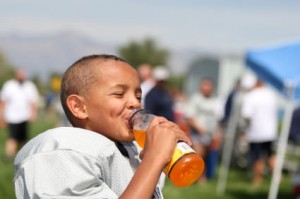In America and all around the world, sports are a huge part of our culture. Playing in the heat is exhausting for anyone but how do you prevent heat stroke? Do you even know what heat stroke is?
Prevent Heat Stroke
In the hot summer months when your athlete is out practicing and playing games, make sure they stay hydrated. One major cause of heat stroke is dehydration. Ensure your athlete drinks lots of fluids especially water and sports drinks. Water keeps the body from getting dehydrated and sports drinks replenish necessary electrolytes lost in sweat. These electrolytes are important to keep your body’s pH levels in balance and in creating electrical impulses that help your heart and your overall physical activity. Staying hydrated is the main pathway to preventing heat stroke all together. Another, tip to keep your athlete healthy is to take frequent breaks when playing and re-hydrate.
Identifying Heat Stroke
Despite your best efforts to prevent heat stroke it is possible that it still may occur. In this case, it is imperative to be able to recognize the signs and symptoms of it. Heat stroke is a medical emergency that can be fatal without immediate attention. There are several signs and symptoms that may occur; a combination of just a few may indicate heat stroke. Below are a few things to look out for while your athlete is being physically active.
1. Skin is hot to touch: The most common sign of heat stroke is that the skin is hot to touch. If the body temperature of your athlete is over 105 degrees, it can be very dangerous.
2. Extreme Fatigue: Exhaustion is expected when playing in the heat, but if the athlete is experiencing extreme exhaustion/ fatigue it may be a sign of upcoming heat stroke.
3. Loss of Sweat: Loss of sweat means that the body is dehydrated to the point it cannot sweat. Pay immediate attention to this and hydrate your athlete.
4. Dizziness or Fainting: Heat stroke can cause dizziness or fainting.
5. Nausea/ Vomiting: Nausea without vomiting is also a sign of heat stroke.
6. Severe Headache: This can be more of a problem than it seems and is a sign of heat stroke
7. Confusion: Difficulty remembering, thinking or focusing is a sign.
8. Rapid Heart Rate: Elevated heart rates result from physical activity but if paired with any of the above signs and symptoms it is very dangerous.
9. Seizures: In extreme cases people with heat stroke may experience seizures.
If your athlete is experiencing any combination of these signs and symptoms get him/her to a hospital as soon as possible and/or call 9-1-1. As mentioned above, heat stoke is a medical emergency and may be fatal if not promptly attended to.
Treatment
If you notice your athlete is showing signs of having heat stroke there are several things you can do to cool them down. First, call 9-1-1. After that, the quickest and most efficient way to cool them down is to wet their body, put a fan on them, and put ice packs in their groin and arm pit regions. If a fan is not available, try to cool them down using cool rags/towels, ice, and cool liquids. The best liquids to use are water or sports drinks, avoid giving them caffeine or alcohol.
Give your athlete the best chance at success by using these tips to prevent heat stroke and see recognize the signs if it happens.



